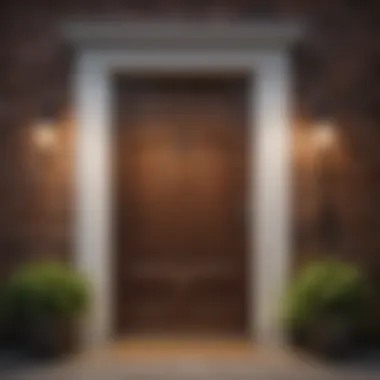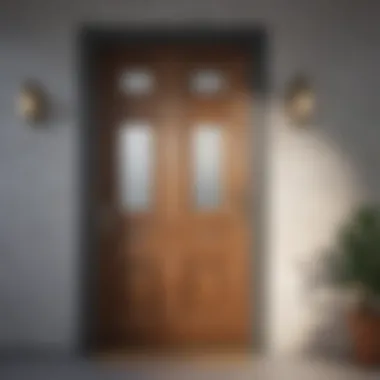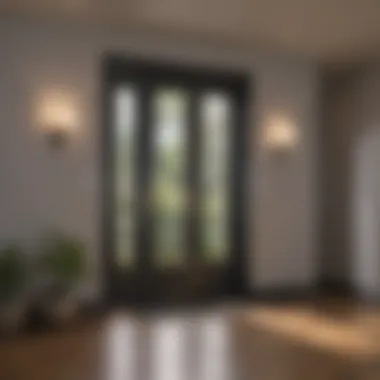Understanding Door Replacement Costs: A Comprehensive Guide


Intro
Replacing a door may seem like a simple task, but it encompasses a range of considerations that impact costs. A door serves not only as an entry point but also as an element of design within a space. The process involves selecting the right door type, considering materials, and hiring professionals who will ensure proper installation.
Here, we will explore the essential details related to the costs involved, giving insights that enable smart financial decisions.
Factors Influencing Cost
Several elements contribute significantly to the overall expense of replacing a door. They help dissect the broad topic into manageable areas of focus, making it easier to evaluate potential costs.
Material Costs
Material selection dominates the cost equation. Doors are available in various materials, each offering differing benefits and price ranges. Common options include:
- Wood: Aesthetic appeal but can be expensive.
- Steel: Durable and often more affordable.
- Fiberglass: Offers good insulation and maintenance ease but can be pricier than steel.
The choice of material not only influences the initial cost but also affects long-term value and maintenance needs.
Labor Expenses
Labor charges vary based on the complexity of the installation. Employing a skilled professional is often advisable to ensure proper fitting and performance. Installation costs can differ based on:
- Location: Urban areas may see higher labor costs.
- Experience: Seasoned installers often charge more for their expertise.
- Installation type: Custom installations may incur additional charges.
Installation and Disposal Fees
Beyond the door and labor, installation fees must be factored in. This includes costs for any necessary modifications or reinforcement around the frame. If the old door needs to be removed, disposal fees may apply as well. This often includes hauling away debris or scheduling bulk pickup services, which may incur additional costs.
Customization Costs
Customization adds another layer of expense to the process. Options include unique designs, hardware choices, and specific finishes. While custom features can enhance aesthetic appeal, they inevitably increase replacement expenses.
"Every component of the door replacement process, from selection to installation, contributes to the overall costs. Knowing them helps avoid surprises."
Epilogue
Prelude
The importance of knowing these costs cannot be understated. Several factors contribute to the total expense, including the type of door, materials used, and installation specifics. Additionally, there are secondary costs such as disposal and customization that may come into play. Homeowners must be aware of these factors to avoid surprises and to budget accordingly.
Moreover, understanding the costs can lead to informed choices about investment in home improvement. A well-selected door not only beautifies the entrance but can also improve energy efficiency and increase property value. As we delve deeper into this topic, we will examine various elements that will equip homeowners with insights necessary for smart decision-making in door replacement.
Understanding Door Types
Understanding different types of doors is critical when considering door replacement. Each type serves distinct purposes and has varying implications for both cost and functionality. Homeowners should carefully evaluate their specific needs, as this will influence not only the choice of door but also the overall financial investment involved. The right door enhances aesthetic appeal, ensures security, and contributes to energy savings.
Interior Doors
Interior doors are designed for use within the home. They primarily function to partition spaces and provide privacy. Common materials for interior doors include hollow core, solid wood, and MDF. Each material varies in cost, weight, and durability.
Hollow core doors are typically more affordable, making them suitable for budget-conscious homeowners. Conversely, solid wood doors, while more expensive, offer better sound insulation and a more upscale appearance. When selecting an interior door, consider factors such as:
- Style and design preferences
- Noise reduction requirements
- Budget constraints
Exterior Doors
Exterior doors serve as the first line of defense against intruders and environmental factors. They need to be sturdy, secure, and energy-efficient. Typically made from materials like fiberglass, steel, or solid wood, these doors can be customized in various ways, enhancing curb appeal.
It is essential to account for several aspects when choosing an exterior door:
- Security features – Look for reinforced locks and sturdy construction.
- Energy efficiency – Insulated doors reduce heating and cooling costs.
- Weather resistance – Doors should withstand extreme temperatures and moisture.
The cost of exterior doors can vary significantly based on material and insulation properties.
Storm Doors


Storm doors are an additional layer of protection for exterior entrances. They are installed outside the main door and primarily serve to shield it from the elements while also providing ventilation. Storm doors are often made of aluminum or fiberglass, offering durability and low maintenance.
Key benefits of installing storm doors include:
- Increased energy efficiency by preventing drafts.
- Extended lifespan and durability of primary doors.
- Enhanced security when locking the storm door.
While the upfront cost may seem like a luxury, storm doors can lead to long-term savings in energy costs and maintenance. This investment can pay off by protecting the main door and reducing heating and cooling expenses.
Understanding the differences and characteristics of various door types enables homeowners to make informed decisions. Choosing the appropriate door type significantly impacts overall satisfaction with the investment made in door replacement.
Material Considerations
When considering door replacement, material choices hold significant weight in terms of costs, durability, and functional features. Each material type brings its own set of advantages and drawbacks that impact both immediate expenses and long-term value. Understanding these factors is essential for making informed decisions that align with aesthetic preferences and practical needs.
Wooden Doors
Wooden doors are often praised for their natural beauty and versatility. These doors can be customized in various styles and finishes, allowing for seamless integration into any home design. The cost of wooden doors will vary widely, influenced by factors such as species of wood, craftsmanship, and whether it is solid or hollow core.
- Benefits: They provide excellent insulation and can be energy efficient. Wooden doors also enhance home facade, giving off an inviting appearance.
- Consideration: One must also think about maintenance. Wooden doors require regular upkeep to prevent warping, swelling, and other weather-related issues. Hence, anticipate additional costs on finishes and repairs over the years.
Fiberglass Doors
Fiberglass doors have gained popularity over the years due to their durability and low maintenance requirements. They can mimic the appearance of wood and offer great insulation properties.
- Benefits: Fiberglass doors are resistant to dents and scratches, making them ideal for high-traffic areas. They also are less likely to warp or rot compared to wood.
- Consideration: While generally more affordable than high-end wooden doors, quality fiberglass options can be pricey. It’s crucial to evaluate the long-term savings on energy bills against the initial investment, especially in climates with extreme weather.
Steel Doors
Steel doors are among the most robust options available. They offer high security and are resistant to various environmental factors. Their cost effectiveness lies in their durability and energy efficiency.
- Benefits: Steel doors typically require little maintenance and are fire-resistant, which adds a layer of safety to your home. They are also energy-efficient, often fitted with insulation.
- Consideration: On the downside, steel doors can be less aesthetically pleasing if styles are not chosen wisely. Ensure to consider the design that will complement your home’s exterior.
Steel doors generally cost less than wooden or fiberglass options but require careful selection to maintain aesthetic value.
Cost Breakdown of Door Replacement
Understanding the cost breakdown related to door replacement is crucial for anyone planning to undertake this home improvement project. This section allows homeowners to grasp the different elements that comprise the total expense involved. It offers insights into the approximate price ranges for various types of doors, the factors that can influence material costs, and the labor costs associated with installation. By breaking down the costs, readers can make budgetary decisions and prioritize their expenditures effectively. This knowledge can ultimately aid in avoiding unexpected financial burdens, leading to a smoother renovation process.
Average Price Ranges
When replacing doors, it is essential to familiarize oneself with average price ranges. This can vary significantly depending on the type of door selected, the materials used, and other circumstances.
- Interior doors generally range between $50 and $300. Common options here include hollow-core doors and solid wood doors.
- Exterior doors can be on the higher end, typically costing between $150 and $1,500. These doors often come with added security features and weatherproof designs.
- Storm doors, which serve as an additional layer of protection, usually cost between $100 and $500.
These price ranges serve as a starting point for budgeting. Homeowners should remember to check for additional features or customizations that might further increase the overall price.
Factors Affecting Material Costs
Several factors determine the material costs of door replacement. Some of these factors include:
- Material Type: The selection between wood, fiberglass, and steel can greatly influence prices. Higher quality materials typically come with higher costs.
- Quality and Brand: Brand reputation and product quality will also affect material costs. Established brands may charge a premium for their products.
- Design Complexity: Custom designs or intricate details increase manufacturing costs. Simple or standard designs tend to be more affordable.
- Market Fluctuations: Prices for raw materials can vary based on market conditions such as supply chain issues or increased demand.
Understanding these factors provides homeowners with insights into how their choices can either elevate or reduce their costs.
Labor Costs
Labor costs can vary widely based on several considerations, which can impact the final price of door replacement projects. Here are the key aspects affecting labor costs:
- Location: Urban areas tend to have higher labor costs compared to rural settings.
- Complexity of Installation: If structural modifications are necessary for the new door, this will take additional time and labor, thus increasing costs.
- Experience of the Installer: Hiring highly skilled professionals may cost more, but it can ensure better quality work.
According to recent data, hiring a professional installer typically costs between $50 and $100 per hour, plus any additional fees. A simple door replacement may only take a few hours, but complex projects can become significantly costlier.
The cost of labor is often a crucial aspect that many homeowners overlook, emphasizing the need for accurate quotes and clear understandings before making decisions.
Overall, carefully analyzing the cost elements related to door replacement ensures that homeowners can navigate their renovation projects with confidence and clarity.


Additional Expenses
Understanding the additional expenses associated with door replacement is crucial for homeowners and property managers. While the direct costs of materials and installation are often front and center, overlooking these ancillary costs can lead to unexpected financial strain. These additional expenses can significantly affect the overall budget. Addressing them ensures that one is fully prepared for the entire project, leading to informed decisions along the way. The main categories of additional expenses include installation fees, disposal fees, and custom features. Each of these has unique aspects that warrant careful consideration.
Installation Fees
Installation fees can vary widely based on several factors, including the complexity of the installation and the specific door type. Homeowners typically overlook these fees when budgeting for a door replacement project. It is essential to gather quotes upfront to avoid surprises later. Hiring a professional to install a door ensures proper fit and function, reducing the likelihood of future issues.
Always ask about warranty terms for installation work, as this can save costs in the long run.
For instance, for basic door types like interior doors, installation may be relatively straightforward, usually costing less. For heavier exterior doors or custom designs, service charges can increase due to the extra labor involved. Homeowners should also consider if any additional framing or modifications are required for installing the new door. Any structural adjustments will add to the overall labor costs.
Disposal Fees
Disposal fees are another often-overlooked expense. When replacing a door, the old door must be removed and disposed of properly. Many municipalities charge fees for bulk waste disposal. These costs can vary significantly by location and should be factored into any door replacement budget.
An alternative route is to inquire if the installation contractor includes disposal in their service. Some companies may offer this as part of the package. However, if this is not included, homeowners may face additional costs for taking the door to a disposal site or recycling center.
Custom Features
Custom features can enhance the appeal and functionality of a door but at an added cost. These features include locks, handles, and decorative accents that cater to individual preferences or requirements. Customization can significantly increase the price of both materials and installation. For example, a specialized handle or high-security lock may add considerable costs compared to standard options.
Additionally, custom sizes may lead to increased labor or installation fees as standard tools may not accommodate them. Homeowners should weigh the aesthetic and functional benefits of these enhancements against their budget constraints.
Ultimately, understanding these additional expenses is essential for effective budgeting. Homeowners should conduct thorough research and seek detailed quotes from contractors to ensure every aspect of the door replacement is considered.
DIY vs. Professional Installation
When it comes to door replacement, the choice between doing it yourself or hiring a professional holds significant importance. This decision not only impacts costs but also affects the quality of the installation and the long-term satisfaction with the new door. Homeowners often find themselves weighing the benefits and drawbacks of each approach, determining which option aligns with their needs and skills. The right choice can lead to enhanced functionality while the wrong one might result in costly mistakes.
Pros and Cons of DIY
Engaging in a do-it-yourself project can evoke a sense of accomplishment. There are several benefits to consider.
- Cost Savings: One of the most appealing aspects of DIY is the potential to save on labor costs. By installing the door yourself, you eliminate approximately 50% of overall expenses.
- Personal Accountability: Taking charge of the installation allows for more control over the project's timeline and quality.
- Learning Opportunity: This experience provides valuable skills that can apply to future home improvement tasks.
However, there are also important disadvantages.
- Skill Level Required: Not everyone possesses the necessary skills for a successful installation. Missteps can lead to improper fitting, and result in damage.
- Time Consumption: DIY projects can take significantly longer than expected, especially for inexperienced individuals, which can disrupt your routine.
- Safety Hazards: Improper use of tools may increase the risk of accidents, presenting potential harm to oneself or damage to property.
In summary, while DIY can be rewarding, it comes with risks that must be evaluated carefully.
When to Hire Professionals
Deciding to hire a professional can alleviate the burdens associated with a DIY project. There are clear scenarios where this choice is advisable.
Hiring a licensed contractor ensures that the job meets local building codes and regulations.
- High Complexity: If the project involves structural changes or intricate detailing, professionals bring expertise that can ensure correct installation.
- Time Constraints: When time is limited and a quick turnaround is necessary, professionals can complete the work efficiently. They often have access to tools and manpower that facilitate a faster process.
- Guarantees and Warranties: Many licensed installers offer warranties on their work, providing peace of mind should any issues arise post-installation. In contrast, DIY projects do not typically offer such protections.
To conclude, while DIY can be a cost-effective option for some, hiring professionals can provide necessary assurance and quality that makes it worth the expense. Homeowners should assess their skills, timelines, and project complexity to make an informed decision.
Regional Cost Variations
Regional cost variations play a significant role in the overall expenses associated with door replacement. The place where a homeowner or property manager resides affects numerous factors, such as labor costs, materials pricing, and market demands. Understanding these regional differences can help buyers make better choices and avoid unexpected surprises in their home improvement budgets.
One of the essential elements influencing cost is the local economy. Some areas might have higher labor costs due to higher living expenses. This means hiring a professional for installation may cost significantly more in cities сompared to more rural locations. Additionally, the availability of specific materials can also vary by region. Some types of doors might be more accessible in metropolitan areas but not as readily available in rural regions, impacting both price and selection.
There are several benefits to considering regional cost variations:
- Better Budgeting: A clear understanding of local pricing can help homeowners allocate their funds efficiently.
- Informed Decision-Making: Knowledge of regional trends aids in selecting the right materials at the right price.
- Local Market Insights: Learning about local market demands can also influence whether to opt for professional services or consider DIY options.
Awareness of these elements is crucial for anyone planning door replacement as it shapes expectations and financial planning.
Urban vs. Rural Pricing


When comparing urban and rural pricing, distinct patterns emerge. Urban areas often present higher costs for both materials and labor. The reasons include:
- Increased demand due to a larger population
- Higher operating costs for businesses in cities
- Greater diversity of high-end options available
On the other hand, rural settings typically have lower labor expenses and more limited material choices. Often, the fewer local suppliers may lead to generic options that might not meet the desired quality or aesthetic. It is common for rural homeowners to travel to urban centers to find higher quality doors or unique styles, but this adds to the cost.
State-Specific Considerations
State-specific variations can also greatly impact door replacement costs. Different states have unique market conditions, building codes, and even climate factors that influence pricing. For example:
- In states like California, where building regulations can be strict, homeowners may face higher costs due to specialized door types that comply with energy efficiency standards.
- In the Midwest, seasonal weather changes might lead residents to prioritize sturdy materials, possibly increasing the average price of replacement doors.
Moreover, certain states may benefit from specific incentives or grants aimed at improving energy efficiency, which can influence the types of doors purchased. By understanding these state-specific considerations, homeowners can better navigate the complexities of the door replacement process.
"Local knowledge is key to making informed decisions about your home improvements. Ignoring regional differences can lead to misunderstandings and unexpected expenses."
The financial landscape regarding door replacement is influenced heavily by regional characteristics. Being informed about these variables empowers homeowners to make strategic choices.
Cost-Effective Alternatives
Finding affordable options in door replacement is essential for homeowners. There are several ways to save money while ensuring quality. Cost-effective alternatives allow individuals to maintain their home aesthetics without overspending. By exploring these options, property owners can make informed decisions.
Refurbishing Existing Doors
Refurbishing existing doors can be a practical and economical choice. Instead of purchasing new ones, updating old doors can breathe new life into a home. This process involves several steps, including cleaning, repairing, and refinishing the doors.
Benefits of Refurbishing:
- Cost Savings: Refurbishing can significantly lower costs compared to new doors. The labor and material expenses might be minimal.
- Custom Thismization: Homeowners can choose colors and finishes that align with their design preferences, giving a personal touch.
- Sustainability: This approach is more eco-friendly, as it reduces waste.
Considerations:
- Evaluate the condition of the door. If it is structurally sound, it is a good candidate for refurbishing.
- Invest in quality materials for refinishing, such as primer and paint. This ensures longevity of the updated look.
Buying Used or Discounted Doors
Another alternative is purchasing used or discounted doors. This strategy not only saves money but allows one to find unique pieces that may not be available in standard retail environments.
Advantages of Buying Used or Discounted Doors:
- Budget-Friendly: Used doors can be substantially cheaper.
- Unique Styles: They may come with distinct characteristics that add to the home’s charm.
- Local Options: Many community groups or online marketplaces offer gently used doors at reasonable prices.
Things to Keep in Mind:
- Inspect the door thoroughly for any damages. Look for signs of wear, especially in the hinges and frames.
- Ensure that the size fits your opening. Custom adjustments can be costly.
By considering these cost-effective options, homeowners can engage in door replacement decisions that balance both functionality and budget.
The Importance of Choosing Quality
When considering door replacement, the quality of the product chosen plays a critical role in the overall satisfaction and longevity of the investment. Low-quality doors may seem like a bargain initially; however, their long-term costs can be much higher than expected. Homeowners must balance upfront costs with the lasting benefits that quality craftsmanship offers.
Long-Term Value vs. Initial Cost
Choosing high-quality doors may require a larger initial expenditure, but this investment pays off over time. Durable materials often lead to fewer repairs and replacements, which means savings in labor and material expense in the future. For instance, a well-constructed wooden door will withstand wear and tear much better than a cheaper, mass-produced one.
Additionally, quality doors are more resistant to environmental factors such as moisture and temperature fluctuations. This means they can maintain their appearance and functionality for a longer period. Homeowners should consider the potential for higher resale value. A good door can enhance curb appeal and attract potential buyers, which could be beneficial if you plan to sell the property in the future.
Energy Efficiency Benefits
Another significant aspect of choosing quality doors is energy efficiency. High-quality doors are often designed with better insulation properties. This contributes to maintaining optimal indoor temperatures.
A well-insulated door helps to reduce heating and cooling costs, making your home more energy-efficient. For example, fiberglass doors generally provide better insulation than poorly made wooden doors. Energy-efficient doors can also lead to increased comfort levels within the home, ensuring that the heated or cooled air remains inside where it belongs.
Epilogue
Key elements to consider when concluding are:
- Cost Transparency: Grasping how each factor contributes to the total cost creates better awareness, allowing for informed decision-making.
- Quality Considerations: The initial expenditure should not overshadow the long-term value that quality doors can provide, enhancing both aesthetic appeal and functionality.
- Energy Efficiency: By understanding how the door materials and installation can influence energy conservation, homeowners can make choices that may reduce long-term utility costs.
"A comprehensive understanding of the costs associated with door replacement empowers homeowners to balance their needs with their budget effectively."
Furthermore, the comparison between DIY and hiring professionals emphasizes the need to assess skills and financial implications. Some homeowners may opt for a cost-saving DIY approach, while others recognize the benefits of professional input.



